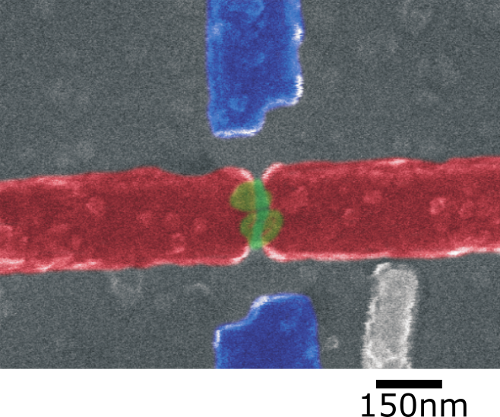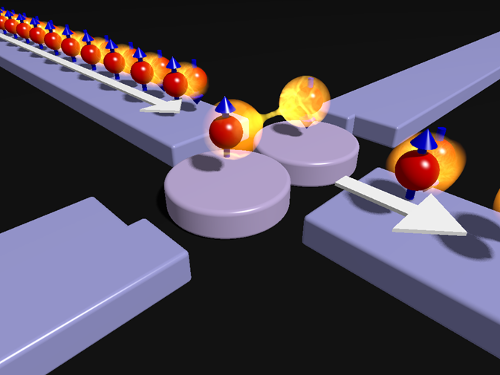Jul. 1, 2015 Press Release Physics / Astronomy
Producing spin-entangled electrons
A team from the RIKEN Center for Emergent Matter Science, along with collaborators from several Japanese institutions, have successfully produced pairs of spin-entangled electrons and demonstrated, for the first time, that these electrons remain entangled even when they are separated from one another on a chip. This research could contribute to the creation of futuristic quantum networks operating using quantum teleportation, which could allow information contained in quantum bits—qubits—to be shared between many elements on chip, a key requirement to scale up the power of a quantum computer. The ability to create non-local entangled electron pairs—known as Einstein-Podolsky-Rosen pairs—on demand has long been a dream.
Russell Deacon, who carried out the work, says, "We set out to demonstrate that spin-entangled electrons could be reliably produced. So far, researchers have been successful in creating entangled photons, since photons are extremely stable and do not interact. Electrons, by contrast, are profoundly affected by their environment. We chose to try to show that electrons can be entangled through their spin, a property that is relatively stable."
To perform the feat, Deacon and his collaborators began the painstaking work of creating a tiny device, just a few hundred nanometers in size. The idea was to take a Cooper pair—a pair of electrons that allows electricity to flow freely in superconductors—and get them, while tunneling—a quantum phenomenon—across a junction between two superconductor leads, to pass through two separate “quantum dots"—small crystals that have quantum properties. “If we could detect a superconducting current," Deacon continues, "this would mean that the electrons, which can be used as quantum bits—the qubits, or bits used in quantum computing—remain entangled even when they have been separated between the quantum dots. We confirm this separation by measuring a superconducting current that develops when they split and are recombined in the second lead.”
The quantum dots, each around 100 nanometers in size, were grown at random positions on a semiconductor chip. This chip was painstakingly examined using an atomic force microscope to discover pairs of dots that were close enough that they might function properly. “We observed thousands of dots and identified around a hundred that were suitable. From these we made around twenty devices. Of those just two worked.”
By measuring the superconducting current, the team was able to show clearly that the spin of the electrons remained entangled as they passed through the separate quantum dots. “Since we have demonstrated that the electrons remain entangled even when separated,” says Deacon, “this means that we could now use a similar, albeit more complex, device to prepare entangled electron pairs to teleport qubit states across a chip.”
According to Seigo Tarucha, leader of the laboratory that conducted the work, “This discovery is very exciting, as it could lead eventually to the development of applications such as quantum networks and quantum teleportation. Though it is technically difficult to handle, electron spin is a very promising property for these applications, as it is relatively free from the environment and lasts comparatively long. It could be combined with photons, by using the spin-entangled electrons to create photons that themselves would be entangled. This could allow us to create large networks to share quantum information in a widely distributed way.”
The work, published in Nature Communications, was done by RIKEN in collaboration with the University of Tokyo, University of Osaka, and was funded by JST and DFG.
Reference
- Russell Stewart Deacon, Akira Oiwa, Juergen Sailer, Shoji Baba, Yasushi Kanai, Kenji Shibata, Kazuhiko Hirakawa and Seigo Tarucha, "Cooper pair splitting in parallel quantum dot Josephson junctions", Nature Communications, doi: 10.1038/ncomms8446
Contact
Group Director
Seigo Tarucha
Research Scientist
Russell Deacon
Quantum Functional System Research Group
Quantum Information Electronics Division
RIKEN Center for Emergent Matter Science
Jens Wilkinson
RIKEN Global Relations and Research Coordination Office
Tel: +81-(0)48-462-1225 / Fax: +81-(0)48-463-3687
Email: pr@riken.jp

False color scanning electron microscope image of the device

Schematic of the device
